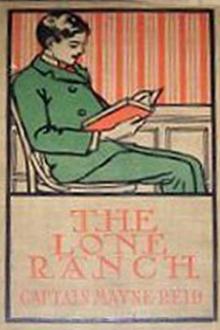The Boy Hunters, Mayne Reid [best love novels of all time .TXT] 📗

- Author: Mayne Reid
Book online «The Boy Hunters, Mayne Reid [best love novels of all time .TXT] 📗». Author Mayne Reid
Basil proposed provoking the bear, by firing upon her. She would pursue them, he urged, as the other had done, and meet with a similar fate. This might have succeeded, but it would have been a dangerous experiment. Lucien suggested that two of them should go round the edge of the precipice and examine it more carefully, while the third kept a watch upon the bear. Perhaps there might yet be found some other path that led to the plain. This offered but a faint hope; still it would take only a few minutes to make the examination, and Lucien’s proposal was therefore agreed to.
“If we only had a rope,” suggested François, “we could let ourselves over the cliff, and then the old grizzly might stay there for ever, if she pleased.”
“Ha!” shouted Basil, as if some plan had suddenly come into his mind, “what dunces we have been! Why did we not think of it before? Come, brothers! I’ll get you down in the twinkling of an eye—come!”
As Basil uttered these words, he strode off towards the spot where they had butchered the big-horns. On reaching it he drew his hunting-knife; and having spread out one of the skins, proceeded to cut it into strips. Lucien, at once guessing his design, assisted him in the operation; while François was sent back to the head of the ravine, in order to watch the bear.
In a few minutes the brothers had cut up both of the hides, until the ground was covered with long strips. These they knotted firmly together—placing cross-pieces of pine branches in the knots—until they had made a raw-hide rope over one hundred feet in length!
They now proceeded to a convenient point of the cliff—where a pine-tree grew near its edge—and tied one end of the new-made rope around the trunk. To the other end they fastened Marengo, the three guns—for François had arrived upon the ground—and, along with these, a large stone—in order to test the strength of the rope before any of themselves should venture upon it. All these things were now lowered down until they could see them resting upon the prairie below.
The rope was next made taut above; and the weight of the stone—which was too heavy for Marengo to move—kept all fast below. François slipped down the rope first. There was but little difficulty in his doing so; as the pieces of wood formed rests, or steps, that prevented him from sliding too fast. Lucien followed next, and then Basil; so that in less than half an hour, from the time that this plan of escape had occurred to them, all three found themselves safe upon the level of the prairie!
They did not waste time when they had got there. Marengo was released, and the whole party hurried in the direction of their horses. These were soon reached, caught, and saddled; and our hunters, now that they could mount at any moment they pleased, felt themselves safe.
They resolved, however, to remain no longer by the butte, but to ride away from it, as soon as they had eaten a morsel. A small fire was, therefore, kindled; and a piece of bear-meat, hastily broiled, satisfied their hunger. Basil would have gone back on horseback, to attack the old she-bear in the ravine; but the more prudent Lucien dissuaded him; and, holding their horses in readiness, they packed their camp equipments upon Jeanette, and once more took the route.
They turned their horses’ heads westward. It was their intention to travel in that direction, until they should strike the tracks of the buffaloes, when they would turn to the north, follow upon the trail of these animals, and endeavour to come up with the great herd. This was clearly the best course they could adopt.
As they were riding past the western extremity of the butte, a flock of large birds drew their attention. They were vultures. The boys now remembered the cimmaron that had fallen over the cliff; and, looking up, they beheld its body still swinging from the tree. It was that which had attracted the vultures.
There were many of them—over an hundred in the flock. Some were sailing about in the air. Others had alighted on the top of the cliff, or perched themselves on the branches of the pines, while a few hovered around the carcass, occasionally settling a moment upon its stiffened limbs, and endeavouring to penetrate the hide with their beaks. They had already torn out the eyes of the animal, but the tough skin of the body still resisted their attacks.
These birds were larger than ravens, and of a dark colour—nearly black. At a distance they appeared purely black; but, upon a nearer view, an admixture of brownish feathers could be perceived, and this was apparent in some of them more than in others. To a careless observer they would all have passed for birds of the same species, although that was not the case. There were two distinct species of them, the “turkey-buzzard” (Cathartes aura), and the black vulture (Cathartes atratus). Our boys knew them well enough—for both kinds are common in Louisiana, and throughout all the southern part of the United States.
I have said that a careless observer would mistake the one species for the other. They are nearly of the same size and colour, though the carrion-crow is of a deeper black than the buzzard; but there are other points of difference that would strike the eye of a naturalist at once. The buzzard is a much more handsomely formed bird, and is more graceful, both upon the ground and while sailing through the air. His wings are longer and more elegantly plumed, and his tail is more tapering. The skin of his naked head and neck, as well as that of his legs, is of a reddish or flesh colour; while the same parts of the black vulture are a mixture of black and grey—the black being caused by a down that grows thinly over the skin. They are easily distinguished in the air. The black vulture flies rather heavily—flapping his wings several times with a quick repetition, and then holding them horizontally for a hundred yards or so—while his short ill-proportioned tail is spread out like a fan. The buzzard, on the contrary, holds his wings at rest—not in a horizontal position, but bent considerably upward. In this attitude he will skim along for a quarter of a mile, without a single stroke of his wings, and that, too, not downward as may be supposed, but along a level, or a line often curving upward! How he executes this upward movement is not known. Some suppose that he possesses the power of inflating himself with heated air, which enables him to soar upward without using his wings. This theory is not very clear, and requires demonstration before it can be accepted as the true one. Others say that he is carried up by the impetus he has already obtained, by having previously descended from an equal or greater height. This is not true, however, as the buzzard may be often seen to rise in this way after a long flight along the level line. It is just possible that the same principle by which the New Holland savages direct their boomerangs, or by which flat stones thrown horizontally often take an upward direction—a fact known to every boy—I say it is just possible that this principle, as yet but little understood, may be instructively acted on by the buzzard, and have something to do with his flight. Be the facts as they may, it is an interesting sight to watch one of these birds, with broad wings outlined against the blue background of the heavens, now swimming in circles, now shooting off in horizontal lines, and anon soaring upward or tracing the undulating curves of the ogee. It is, to say the least of it, a striking and beautiful sight.
The turkey-buzzard is, upon the whole, a nobler bird than the black vulture. There is more of the eagle about him. Both, it is true, are carrion-feeders, like all vultures; but the buzzard also hunts after other food, such as snakes, lizards, and small quadrupeds. He will attack young lambs or pigs, when a good opportunity offers. So, too, will the black vulture, but not so frequently. Neither of them, however, do much harm in this respect; and their preying on such animals is an exception, and not a rule. They only do so, probably, when driven to it by hunger. Both species are gregarious, although they do not always appear in flocks. The buzzards, particularly, are often seen hunting alone, or in twos or threes; but their mode of life brings them together in large numbers. They often assemble—both buzzards and black vultures—to the number of hundreds, over a single carrion. The buzzards, however, are not so plenty as the black vultures; and in one of these flocks more than three-fourths will be found of the latter species. The buzzards are the shyer birds; and they are less disposed to keep together in flocks. It has even been said that these are not gregarious, as they are often seen alone in the high regions of the air. But it is certain that not only do numbers of them roost together at night, but they even associate with the black vultures at such times.
In most countries the vulture is a privileged bird. He is looked upon as a cheap and useful scavenger, clearing away the carcasses of dead animals, that would otherwise pollute the atmosphere. This is a matter of much importance in hot countries; and it is only in such countries that vultures are commonly found. What a beautiful illustration of the completeness of Nature’s laws! As you get into high latitudes and colder regions—where the air is not so readily tainted by putrid substances—the necessity for such a scavenger no longer exists, and he is rarely met with. There the great vulture gives place to the croaking raven, and the small carrion-crow.
Vultures, I have said, are privileged birds. In most countries they are protected by law. This is the case with regard to the present species, both in English and Spanish America, where there is a fine for killing them. The consequence is, they are seldom molested; and in many places are so tame, that they will permit you to come within a few feet of them. In the cities and villages of the Southern States they alight in the streets, and go to sleep upon the house-tops. They do the same in the cities of Mexico and South America, where both species are also found.
As soon as our young hunters had got opposite the cliff where the vultures were, they reined up, determined to remain awhile, and watch the manoeuvres of the birds. They were curious to see how the latter would conduct themselves with a prey so singularly situated, as was the carcass of the cimmaron. They did not dismount, but sat in their saddles, about an hundred yards from the cliff. The vultures, of course, did not regard their presence; but continued to alight, both upon the escarpment of the precipice and upon the loose rocks at its foot, as if no one was near.
“How very like the buzzards are to hen turkeys!” remarked François.
“Yes,” rejoined Lucien, “that is the reason why they are called ‘turkey-buzzards.’”
François’ observation was a very natural one. There are no two birds, not absolutely of the same species, that are more like each other than a turkey-buzzard and a small-sized turkey-hen—that is, the common domestic turkey of the black variety, which, like the buzzard, is usually of a brownish colour. So like are they, that, at the distance





Comments (0)